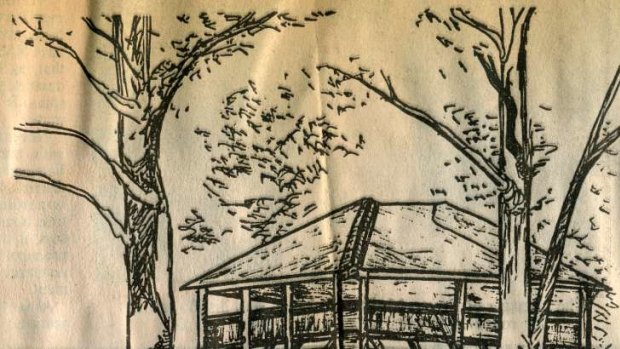
Susan Parsons' 1984 sketch of the wooden structureCredit: Susan Parsons
I have been absolutely besieged with correspondence about the elaborate tree house partially hidden among trees on the side of the Hume Highway near Menangle (‘‘Tree House Mystery’’, June 23). At the time of writing, I’ve received 137 emails from other travellers, who like me use the mystery wooden structure as a landmark on the drive from Sydney to Canberra. Incredibly, among this mountain of emails are almost as many different theories as to the origins of the elaborate tree house. To illustrate the variety of theories, I present them here, without judgment.
Internment Camp: ‘‘While travelling past the structure a bus driver once told me that during World War II there was an internment camp on that site for enemy aliens and that it was a guard tower for that camp,’’ writes Maurice Lynch, of Downer. ‘‘It is my understanding the vegetables and maybe fruit were grown at the site for use in the camp and for sale in Sydney. From our vantage point on the bus you could identify where the market gardens had been laid out.’’
Meredith Hinchcliffe, of O’Connor, agrees with Maurice’s explanation and adds, that there is (or was) a similar tower on the other side of the highway.
Theme park: ‘‘That tree house was part of an early theme park (with animals and hay rides) called ‘Adventureland’ or something similar,’’ writes Michael Kirby, of Chisholm. ‘‘Families (including mine) would spend the entire day there in the 1970s exploring and running around, then a picnic lunch and later play cowboys and indians with the tree house as the fort.’’
Guard Tower: Kerry Burleigh, of Dickson, recalls that in the 1950s her family ‘‘drove past this place on our yearly trip to Wollongong from Forbes and my father said that he used to go to the dentist near there during the war. It was on an army base set up in wartime for training. It may not have been the dentist’s, but it does look like a guard house. My father was based there in the Light Horse (before it was disbanded) in 1940 or 1941. I often go past it now and think of my father talking about it as we made our way to Wollongong,’’ says Kerry.
In support of Kerry’s theory is Jerry Bishop who ‘‘was told that it was built for officers to observe, assess and control, field manoeuvres by troops.’’
Leave it to Google: A number of readers turned to their trusty search engines in search of the truth. Jas Hugonnet stumbled upon www.redbubble.com, which claims that the timber structure was a sleeping quarters from the early days of working the land and was elevated in an attempt to ward of the mozzies. Meanwhile many, including Bill and Mary Crowle, who ‘‘have driven past it for over 40 years and wondered about its origins’’, pointed to another website which says it was ‘‘a slaughterhouse on the old Gilbulla Estate’’.
Tank stand: Sharon Loiterton, of Dunlop, believes it may have housed a water tank or was an old meat storage shed. ‘‘Before refrigeration was common this type of construct was used to hang meat and keep it cool. The open area was covered with an open weave hessian and kept damp from a water container on the roof. This structure would have been built sometime before World War II.’’
Storage shed: Fellow Canberra Times columnist Susan Parsons recalls sketching the structure for an article she penned in 1984 on tree houses. In 1989, at nearby Mount Annan Botanic Gardens, Susan met a member of the family who, at the time, owned the property on which the wooden structure is built and recalls being told it was a storage shed or fire tower.
Summerhouse: Claire Hinton’s family has been wondering about the tree house since 1973 and recalls reading a book that claimed the structure was a summerhouse built for a French winemaker.
Survival hut: Being captivated by the structure after seeing it as a kid and thinking it would be ‘‘the best cubby house ever’’, Ben Roberts, of Hawker, asked Sydney Catchment Authority several years ago if they knew anything about it.
‘‘They responded that they didn’t have a definitive answer, but believe it may have been survival hut/campsite for surveyors trying to find the best route to gravity feed water from the dams in the area.’’
The verdict? I am on the cusp of solving this mystery and will reveal all next week, but in the meantime, given the extraordinary interest in this over-sized cubby, I’m half considering approaching its owners with a proposal to restore it and turn it into a roadside cafe.
I know at least 137 people who would stop just to get a close-up look.
**** Please note, an update to this story appears here.
Sign up for the Traveller newsletter
The latest travel news, tips and inspiration delivered to your inbox. Sign up now.